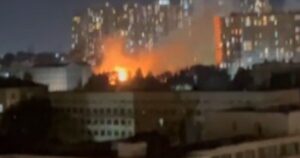What you can do within ten minutes of a WW3 nuclear attack | UK | News

The simmering conflict between Iran and Israel has sparked fears of a potential global war, with concerns mounting over the prospect of World War III.
Recent intelligence reveals that the US has launched military strikes on Iranian nuclear facilities, deploying massive 30,000-pound bunker-busters. These actions, coupled with Israel’s aerial assaults on Tehran, have significantly escalated regional tensions and stoked international anxiety.
At the same time, Russia’s ongoing conflict in Ukraine sees President Vladimir Putin recruiting North Korean troops to bolster his forces.
Peace advocates have pinpointed certain nations as potential havens due to their geopolitical stance, commitment to military neutrality, and overall stability; they’ve also provided guidance on safety measures in the event of a nuclear explosion.
The International Commission on Radiological Protection (ICRP) advises that “adequate preparation and appropriate response to a nuclear alert or detonation can protect you and your family’s health and life,” reports the Mirror US.
Where is the best place to hide if a nuclear bomb strikes?
In the critical first ten minutes following a nuclear blast, “the best way to protect you and your family before, during, and after a nuclear blast is getting inside the center of a building or basement.”
In the aftermath of a detonation, experts advise that you should have at least 10 minutes to seek refuge before fallout begins. If you’re able to get to a multi-storey building or basement swiftly after the blast, head there straight away.
The most robust structures are those built from brick or concrete, while underground car parks and tube stations can also provide substantial shelter.
What happens if I’ve been explosed to radiation?
Should you suspect you’ve been exposed to fallout, it’s crucial to shed outer garments and shoes that might be contaminated. It’s important to cleanse any exposed skin and hair thoroughly.
For pets that may have come into contact with fallout, brush them in an isolated area away from others and bathe them if feasible.
How will I know what is happening in a nuclear strike?
The ICRP recommends tuning into accessible media channels, such as AM/FM radio stations on a battery-powered device, within 24 hours following a detonation for fresh instructions and clear signals. “Stay inside unless instructed otherwise,” their website advises.
Their guidance continues: “Remain in the most protective location (basement or centre of a large building) for the first 12 – 24 hours unless threatened by an immediate hazard (e.g., fire, gas leak, building collapse, or serious injury) or informed by authorities that it is safe to leave.”
Should I attempt to leave my nuclear shelter?
Self-evacuation should only be contemplated when hazardous fallout zones are definitively marked and secure evacuation paths are determined. Meanwhile, key workers might be permitted to exit shelters temporarily to perform essential support and life-saving duties.
How will I know a nuclear attack is happening to begin with?
Thinking ahead about the perils of a nuclear explosion can guide you to take swift and sensible actions for your safety if this dreaded outcome ever happens. A bright flash, visible from 10 km away, signifies a nuclear detonation.
Following this, a fireball generates thermal pulses lasting seconds, inflicting burns, injuries, and setting alight materials such as vegetation and wood several kilometres from the blast.
The fireball and subsequent shock wave have the potential to obliterate city blocks and inflict damage on buildings kilometres away, with flying debris posing additional threats. Initial radiation may injure or even prove fatal to those outdoors within a few kilometres.


